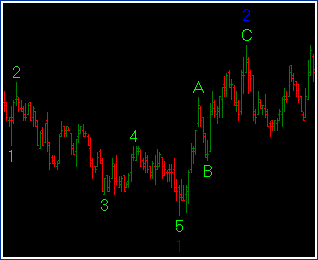Counting on the Waves: A New Look on the
Celebrated Trading Method
The Elliott Wave theory has been a major
thing in trading for decades now and,
undoubtedly, Mr. Ralph Nelson Elliott should be
held in high esteem by all those who trade the
markets these days. However, while some
steadfast followers consider his theory to be a
highly effective pattern recognition technique
able to help predict market developments, others
are prone to regard Elliott's creation as a
commonly used methodology, a brilliantly created
means of seeing the recent past of the market,
rendering this past with stunning clarity. Who's
right and who's wrong?

The Elliott approach construes market actions
as recurrent phases, comprised of two major
moves: a five-wave advance and a three- wave
decline, customarily referred to as the
Impulse Wave and Corrective
Wave. According to the Elliott theory,
the market phases are scalable and the same
market actions can constitute the same but
larger or smaller phases and be considered over
time periods that differ in duration
significantly. By identifying the current
position in the phase, it is possible to predict
the kind of market action that will follow. This
is made easier by the following interpretation
rules for the counting of the waves:
- Wave 2 should not end below the
beginning of Wave 1;
- Wave 3 should not be the shortest wave
among Wave 1, 3 and 5;
- Wave 4 should not overlap with Wave 1,
except for wave 1, 5, a or c of a higher
degree;
- Rule of Alternation: Wave 2 and 4 should
unfurl in two different wave forms.
One of the sub-waves 1, 3, 5 of the Impulsive
Wave is supposed to be an extended wave. For a
better understanding of the Corrective Wave
phase, the Elliott theory delineates the
following types of sub-waves that can make up
the Corrective Wave: Zig-Zag, Flat,
Irregular, Horizontal Triangle, Double Three,
Triple Three. This stringently ordered,
if a bit complicated in places, and revered by
many theory seems to provide an effective means
of analyzing market developments and only God
knows what would happen if it worked completely
as stated. Basically, all you have to do is
determine which of the itemized wave forms is
going to arise next. And here is where the
pitfalls start. And God forbid we call into
question the accuracy of Mr. Ellliott's concept,
Fibonacci's Golden Ratio it is based on, or the
laws of the Universe the latter claims to
explain. The problems are a lot more trivial.
How will you determine the starting point for
your count of the waves? Out of five people who
will look at the same chart two will most
probably see the starting point differently.
Right from the outset, the ticket for your
journey to success seems to be hard to get hold
of.
However, if you've been able to identify the
starting point correctly, you will very soon
understand that identifying waves as they are
occurring is something altogether different from
identifying waves when they have already
occurred. And this is the second and biggest
disadvantage of the Elliott theory.
Unfortunately, there are several more. Is there
going to be the fifth wave? Will the correction
be flat or zigzag? Which of the waves will have
the extension? All these are questions Elliott's
theory has difficulty answering.
It is true that many experienced traders who
have extensively dealt with the "bugs" the
theory contains use the Elliott method as a
predictive technique. However, all the above has
caused many thinking traders to form a vision of
the Elliott theory as of a methodology, rather
than a predictive technique. In their opinion,
this methodology has been extremely helpful in
naming and identifying different states of the
market: strong and week trends, complex and
simple corrections. This can help gainfully use
the other methods in your combination at the
opportune time.
This view on the Elliott theory and the
approach on which some of the thinking traders
base their use of Elliott waves seems to be
quite correct: the main value of the
method is the possibility of determining the
phase the market is currently in. And
this is too valuable an addition to any thinking
trader's arsenal to overlook or underestimate.
Dima Vonko |